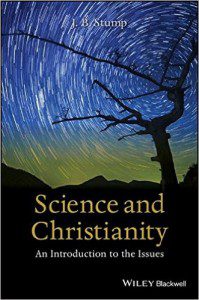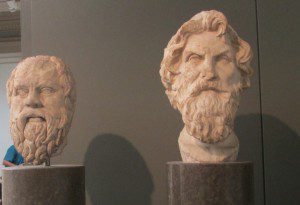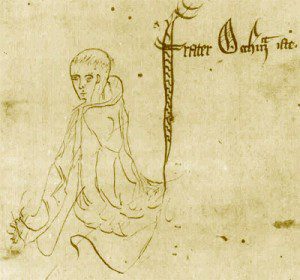 How should we think about divine action?
How should we think about divine action?
As Christians we believe in a personal God who acts in relationship with his creatures and to his creation. Christianity is theistic not deistic. But the question of divine action – how God can (or cannot) interact with his creation has become a significant question. We wonder if God’s action should be scientifically testable or discernible. Is God a cause from within creation or outside of creation? Chapter 10 of J. B. Stump’s recent book Science and Christianity: An Introduction to the Issues, looks at these questions.
 In classical Greek philosophy Aristotle argues that cause can be broken down into four complementary answers. Jim Stump uses the example of Michelangelo’s statue of David to illustrate the differences (p. 120):
In classical Greek philosophy Aristotle argues that cause can be broken down into four complementary answers. Jim Stump uses the example of Michelangelo’s statue of David to illustrate the differences (p. 120):
- The efficient cause of the statue is Michelangelo’s chiseling the block of marble into the shape that it now has.
- The material cause of the statue is the substance that it is made – the marble – which provides some limitation to what it could be (we couldn’t make an enduring statue out of butter).
- The formal cause of the statue is the kind of thin that it is; according to both Plato’s and Aristotle’s metaphysics, there are essences of things which determine the kind of thing an object can be.
- The final cause of the statue is the purpose for which it was made.
 Today, after the rise of scientific thinking over the last 600 years or so, we more or less limit discussions of cause to the efficient cause – the material chain of events that led to the object taking the natural form in which we find it. “This limitation to efficient causes is what makes divine action such a difficult problem. There is no room for purposeful action of any agents – human or divine – so once we understand the efficient causes of something, our minds today are conditioned to think there is nothing else to say.” (p. 120) Jim traces this back to the principle known as Ockham’s razor. According to Wikipedia: “His principle can be interpreted as stating Among competing hypotheses, the one with the fewest assumptions should be selected.” Jim’s summary is similar “The closest statement of the principle in Ockham’s works is “a plurality of hypothesis must never be posited without necessity.” (p. 122)
Today, after the rise of scientific thinking over the last 600 years or so, we more or less limit discussions of cause to the efficient cause – the material chain of events that led to the object taking the natural form in which we find it. “This limitation to efficient causes is what makes divine action such a difficult problem. There is no room for purposeful action of any agents – human or divine – so once we understand the efficient causes of something, our minds today are conditioned to think there is nothing else to say.” (p. 120) Jim traces this back to the principle known as Ockham’s razor. According to Wikipedia: “His principle can be interpreted as stating Among competing hypotheses, the one with the fewest assumptions should be selected.” Jim’s summary is similar “The closest statement of the principle in Ockham’s works is “a plurality of hypothesis must never be posited without necessity.” (p. 122)
Ockham’s razor has come to mean that if a natural mechanism for some phenomenon exists we should not posit the involvement of any supernatural being, whether God, a leprechaun, or a flying spaghetti monster. As a corollary, this manner of thinking has led some theologians to question the possibility of miracles. The world we see around us appears to represent the work of an absentee God who started the process and stepped away.
Miracles. Many different approaches have been taken to the explanation of miracles – from total denial, to the scientific explanations finding space for God’s action in quantum uncertainty and chaos. John Polkinghorne thinks through these ideas in many of his books (you can find a list of books on his Amazon page). Jim separates quantum uncertainty and chaos, but I think we need to consider these simultaneously. I do hold to the “Copenhagen Interpretation” that quantum events are genuinely random and can only be described probabilistically. Chaos theory has to do with extreme sensitivity to initial conditions – classically this means that the inability to predict future events is only the result of imperfect knowledge of the system at one time (assigned as t=0). In quantum theory, however, there is always some intrinsic uncertainty. Taken together, we can have a reality that is not completely causally closed. (In a causally closed system, perfect knowledge of conditions at one time permits complete understanding at all subsequent (and prior) times.)
If there is a realm of existence beyond the physical world we experience, i.e. if there is a God, there is another argument against causal closure of the physical world as well. The rules that govern our physical universe may not describe all of reality. To attribute the laws of physics to all of reality “is an assumption of science which is metaphysical or theological, not a scientific conclusion.” (p. 125)
A God who can intervene, but only does so sparingly raises another kind of problem for many people – the problem of evil. If God can intervene, but doesn’t, thereby permitting all kinds of moral and natural evil, what kind of God is he? Many find it hard to claim this is the action of a God who is love. This question will come up again in a later chapter on the problem of evil.
Mind and Relationship. I am not convinced searching for space for divine action in quantum uncertainty and chaos is the right approach. A better approach is the one Jim ends the chapter with. When a mind is involved in the process there can certainly be multiple levels of cause for an event. John Polkinghorne uses a teakettle example. If a teakettle is boiling it can be described scientifically: fire causes the water in the kettle to increase in kinetic energy, thereby causing the vapor pressure of the liquid to reach the atmospheric pressure, at which time boiling occurs. It can also be described according to the purposeful actions of a mind – I wanted a cup of tea before going to bed, or I wanted to boil crayfish from the lake to eat them (something we used to do on canoe trips in the Boundary Waters).
Ockham’s razor should not be taken as some absolute rule separating divine action from natural cause. It is not unreasonable to posit layers of cause similar to the reasoning of the ancient Greeks and of Thomas Aquinas. There can be both primary cause and secondary cause.
If God is a personal being as the Christian creeds attest, then it is perfectly legitimate to explore that personal aspect of reality in theological terms while at the same time encouraging others to explore the level of description more appropriate to the fundamental laws and forces of nature. And just as the two explanations for the teakettle boiling are not in conflict, neither are scientific and theological explanations of an even in conflict.
Some might criticize this approach as succumbing to the Independent thesis discussed in Chapter 1, in which science and theology have no common ground. … But there is an important difference in the approach being commended in this chapter: scientific explanation and personal (or theological) explanations are talking about the same thing, just appealing to different aspects of it. (p. 130)
Humans can be both the result of evolutionary processes and the result of the intentional purposes of God. These are not competing explanations.
How do you think about divine action?
Is this a problem?
If you wish to contact me directly you may do so at rjs4mail[at]att.net.
If interested you can subscribe to a full text feed of my posts at Musings on Science and Theology.











